

Teaching kids to read during the coronavirus pandemic: 5 questions answered. Keisha McIntosh Allen and Kindel Turner Nash research how kids learn to read and prepare future teachers at the University of Maryland Baltimore County.
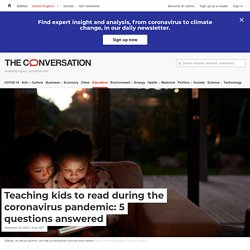
They are also raising children of their own. Here, they answer five questions many families and teachers may have about what they are seeing with virtual learning for early childhood education. 1. How do most kids learn to read? Nash: Long before they enter kindergarten, most kids can “read” the words they encounter in their favorite books or around their home, on street signs and anywhere else they go. Allen: Establishing routines that involve reading can help, such as reading them books – whether they are printed on paper or accessed through digital devices – and letting them watch others read. Kids typically learn to read books through a series of phases, which often overlap. Nash: Making reading fun can also develop a love of reading. 2. Allen: Social distancing could pose real challenges. 3.
Research: How to turn students' wishes into action. New research suggests a relatively simple technique could have teachers WOOPing at their students’ achievements, says Harry Fletcher-Wood We usually want students to do something differently, whether it’s working harder in lessons, doing homework more regularly, or being nicer to a peer.

Blog: What learning should we be promoting for home during school closures? These are unprecedented times.
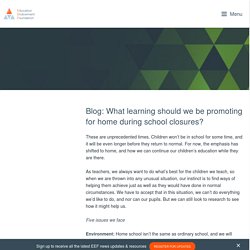
Children won’t be in school for some time, and it will be even longer before they return to normal. For now, the emphasis has shifted to home, and how we can continue our children’s education while they are there. As teachers, we always want to do what’s best for the children we teach, so when we are thrown into any unusual situation, our instinct is to find ways of helping them achieve just as well as they would have done in normal circumstances. Remote learning: why hasn't it worked before and what can we do to change that? - Daisy Christodoulou. Back in 2008, the business professor Clayton Christensen made a prediction that by 2019, half of all US high school classes would be taken online.
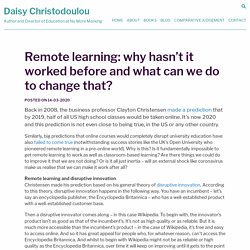
It’s now 2020 and this prediction is not even close to being true, in the US or any other country. GUEST POST: Using Evidence Based Strategies to Improve the Distance Learning Experience — The Learning Scientists. Alison Stone teaches Human Anatomy and Physiology and AP Biology at Central Bucks High School – West in Doylestown, PA.
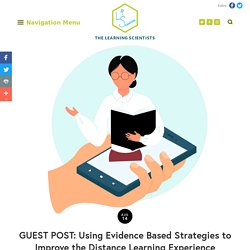
She is a National Board Certified Teacher and the 2015 recipient of the Outstanding Educator Award from Stephenson University. Alison has a passion for using evidence-based practice to improve student outcomes in her classroom. She can be found on Twitter at @alisonstoneCBSD. When my in-person classes suddenly ended on March 12th, like many teachers across the country, I felt adrift and without a clue as to how to proceed. After the initial shock, I remembered that I had a pair of extra paddles stashed in my boat that could direct my instruction: retrieval and spaced practice.
I became interested in the applications of cognitive science research in the classroom three years ago. Schola liberum. Covid pandemic has given the world a great online learning experiment. Text Size: When we were told over the Lunar New Year holiday that schools in Hong Kong would be closed to prevent the spread of a then still-distant illness, I went through all the stages of grief.

Shock, denial, anger, bargaining. EEF Blog: Five-a-day - achieving effective learning behaviours within our classrooms. What are learning behaviours - and how can schools support pupils to develop them?
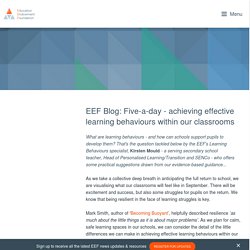
That's the question tackled below by the EEF's Learning Behaviours specialist, Kirsten Mould - a serving secondary school teacher, Head of Personalised Learning/Transition and SENCo - who offers some practical suggestions drawn from our evidence-based guidance... As we take a collective deep breath in anticipating the full return to school, we are visualising what our classrooms will feel like in September. There will be excitement and success, but also some struggles for pupils on the return. We know that being resilient in the face of learning struggles is key. Mark Smith, author of ‘Becoming Buoyant’, helpfully described resilience ‘as much about the little things as it is about major problems’.
What are effective learning behaviours? A learning behaviour is any behaviour that supports learning, such as paying attention to the teacher or persevering with a tricky task. 1. 2. 3. 584543 great teaching toolkit evidence review. Video: Retrieval Practice in Asynchronous Instruction - Teach Like a Champion. As you can tell from reading this blog, our team has been furiously watching footage of online instruction.
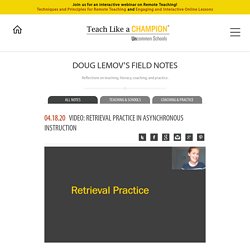
We’ve been inspired by the enthusiasm and humility of teachers as they take on sudden new challenges in the name of remote instruction. Last week we watched several teachers doing Retrieval Practice as part of their online lessons. We were struck, first, by how important and valuable Retrieval Practice was as an online activity and also how well it lent itself to asynchronous instruction especially. Mastering Remote Teaching- Intro: Two types of Learning - Teach Like a Champion. As you probably know, watching video of teachers in action and sharing bright spots is what my team and I love to do.
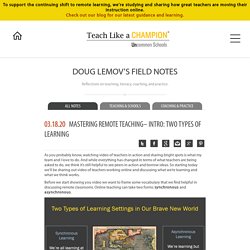
Blended Learning Definitions. For a full overview on blended learning basics and models, visit the Blended Learning Universe, an online hub curated by the Christensen Institute.
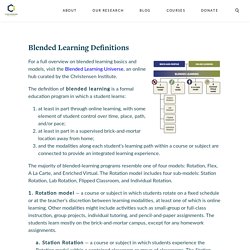
The definition of blended learning is a formal education program in which a student learns: at least in part through online learning, with some element of student control over time, place, path, and/or pace;at least in part in a supervised brick-and-mortar location away from home;and the modalities along each student’s learning path within a course or subject are connected to provide an integrated learning experience. The majority of blended-learning programs resemble one of four models: Rotation, Flex, A La Carte, and Enriched Virtual. The Rotation model includes four sub-models: Station Rotation, Lab Rotation, Flipped Classroom, and Individual Rotation. 1. A. B. C. D. 2. 3. 4. The blended learning models that can help schools reopen. May 27, 2020 As educators start considering their options for the fall, the future is full of uncertainty.
If schools remain closed, they’ll need to prepare for more remote learning. On the other hand, there’s a chance schools might be able to open back up, in which case they’ll likely need to have students come in shifts in order to maintain social distancing. Fortunately, if bringing students to school part-time is an option, schools don’t have to invent new approaches from scratch. Two of the blended-learning models we’ve documented are well suited to these circumstances: the Enriched Virtual model and the Flipped Classroom model.